Specialists in Arthroscopic Knee and Shoulder Surgery
-
Simple knee arthroscopy
More information -
Knee arthroscopy with meniscus repair
More information -
Arthroscopy with ACL and PCL Repair
More information
Simple Shoulder Arthroscopy
More informationShoulder Arthroscopy with Rotator Cuff Repair
More informationShoulder Arthroscopy with LABRUM (SLAP OR BANKAT) repair
More informationWe have the specialized medical personnel indicated to treat your conditions
We offer a team of specialist medical providers and implants from the best brands for arthroscopy and repair of the different injuries that occur in the knee and shoulder, aimed at all those people who live with pain and/or injuries in any of these joints.
What is simple arthroscopy?
Arthroscopy is a type of endoscopic surgery that mainly helps us in the diagnosis or repair of an injury to one of the joints. It is performed using very precise surgical instruments without the need to make large incisions in the body, which is why it is considered a minimally invasive surgical procedure.
Stay in clinic: Short stay
Duration: 30 -90 minutes
Anesthesia: Regional
Simple joint:
How is Knee Arthroscopy performed?
The surgeon will make small incisions in your knee. A sterile solution will be used to fill the knee joint and remove any cloudy fluid, this helps your surgeon see your knee clearly and in detail.
Your surgeon's first task is to insert an arthroscope. If surgical treatment is necessary, the surgeon will insert tiny instruments through another small incision. These instruments can be scissors, razors or lasers.
This procedure usually lasts 30 minutes to a little over an hour. How long it lasts depends on the results and the necessary treatment.
Knee arthroscopy is most commonly used to:
- Cut out broken pieces of articular cartilage
- Remove loose fragments of bone or cartilage
- Remove inflamed synovial tissue
Finally, the surgeon closes the incisions with a suture and covers it with a soft bandage.
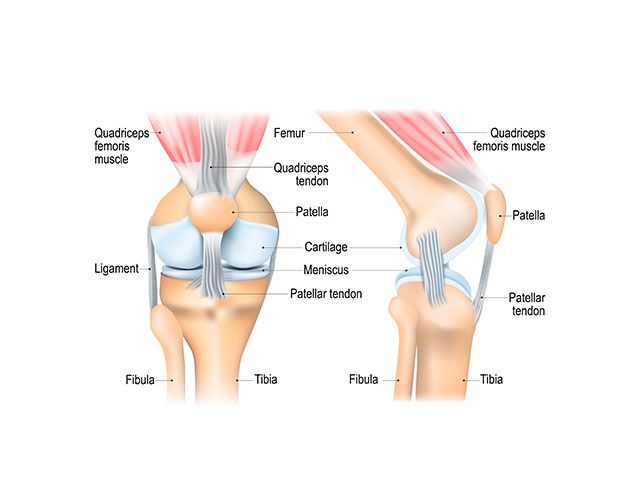
-
What will my recovery be like after knee arthroscopy?
Recovery from knee arthroscopy is much faster than traditional open knee surgery. Still, it is important to follow your surgeon's instructions carefully after you return home. You should ask someone to accompany you the first night at home.
-
Candidates for knee arthroscopy surgery
The procedure is recommended when the following symptoms occur:
-
Knee Anatomy
The Knee is one of our most important joints in the body. It is made up of 21 muscles in total, which provides it with the flexion and extension properties and the important union of two bones, the femur in its distal area and the tibia in its proximal area.
Simple Knee Arthroscopy Package
- First assessment consultation with a certified specialist, free/virtual. Medical fees (complete medical team for the day of the intervention, surgeon, two surgical assistants, 1 surgical nurse, anesthesiologist).
- Personalized advisor who will take care of all the logistics for your intervention.
- Necessary transport derived from and for your treatment.
- Laboratory and office exams if required.
- One day of hospitalization (if you come from outside) if you are local you can be discharged the same day.
- Reservation and use of surgical instruments, complete equipment, surgical and healing supplies during your hospitalization.
- Stay in recovery room, monitored.
- PCR test (not included). It must be sent 72 hours before the procedure, it must be no more than 3 days.
- Personalized follow-up after surgery.
It is a minimally invasive procedure that consists of repairing meniscus injuries without having to open the knee.
It is carried out through two or three small incisions around the joint, through which all the technological and anatomical material, both optical and instrumental, is introduced, as well as the implants necessary to carry out the treatment of the meniscus injury.
There are two fundamental techniques to repair a meniscus fissure or tear with arthroscopy:
1. PARTIAL MENISCECTOMY: It is the removal of the part of the affected meniscus. It is remodeled in such a way that the smallest amount of meniscal tissue can be removed and thus preserve the most functional tissue.
2. MENISCUS SUTURE: In this technique, the injury is sutured. This is the most used technique because it preserves the meniscus intact and has the best long-term results.
What is Knee Arthroscopy with Meniscus Repair?
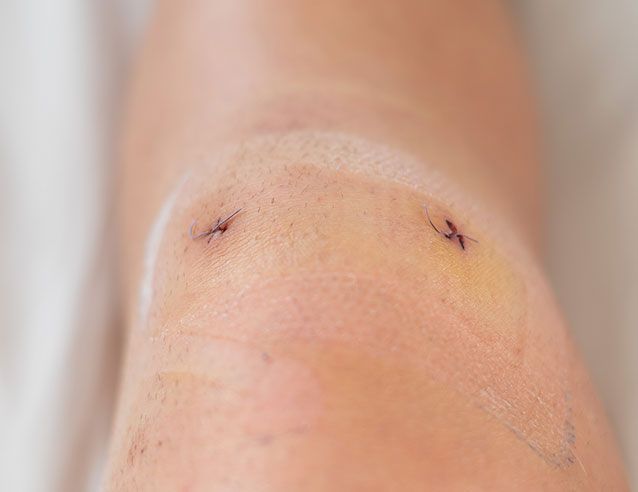
-
What will my recovery be like after my Meniscus Surgery?
The meniscus repair operation is performed through arthroscopy, which is a minimally invasive procedure. For this reason, the time in the recovery room is minimal; you are normally discharged the same day you undergo surgery.
-
What to expect after meniscus surgery?
After the intervention, the inflammation must be taken care of, with the application of topical cold, with pressure, but you can make movements with these measures from the first moment.
-
What are the risks when undergoing meniscus repair surgery?
Like any intervention, it has some risks, but in this case the percentage is very low, however, the following could occur:
-
Frequent questions
What is the meniscus?
-
Arthroscopy package with meniscus repair
- First assessment consultation with a certified specialist, free/virtual. Medical fees (complete medical team for the day of the intervention, surgeon, two surgical assistants, a surgical nurse, anesthesiologist).
What is Arthroscopy with ACL Repair?
Anterior or posterior cruciate ligament reconstruction involves replacing the torn ligament with a graft. The graft is usually taken from a tendon from another part of the body, but sometimes it can be made from a donor graft (allograft).
Cruciate ligament reconstruction is performed to address knee stability, which means you may be able to return to sports.
The arthroscope and other specialized instruments are inserted through several small incisions in the skin at knee level.
The arthroscope is the thin instrument with a camera and light that will allow the surgeon to view the inside of the knee. Once the instruments are inside, the portion of the torn ligament is extracted and the area is prepared for the reception of the new ligament (graft) of the hamstring tendons in the back of the knee or it may be the patellar tendon that connects the kneecap with the tibia
Stay in clinic: 1 day
Duration: 45- 120 minutes
Anesthesia: Regional/Sedation
Recovery: 4 to 6 months
Arthroscopy with ACL Repair:
The surgeon drills a tunnel through the tibia to the bottom of the femur. He will place the graft in the tunnel, attach it to the bone normally with screws, this material is left inside the knee and some materials are absorbable (integrated into the bone) and finally the skin incisions are closed.

-
What to expect from cruciate ligament reconstruction surgery?
You should rest until the anesthesia wears off. You may need pain relievers to relieve discomfort when the anesthesia wears off.
-
What will my recovery be like after cruciate ligament reconstruction?
You will be discharged with instructions to take medications with a schedule for pain, inflammation and infection, cold therapy can be applied to the joint to relieve
-
Frequent questions
What are the ligaments of the knee?
-
Arthroscopy Package with Cruciate Ligament Reconstruction
- First assessment consultation with a certified specialist, free/virtual. Medical fees (complete medical team for the day of the intervention, surgeon, two surgical assistants, a surgical nurse, anesthesiologist).
What is simple shoulder arthroscopy?
Shoulder Arthroscopy is a procedure that consists of visualization of the shoulder joint and the subacromial space, through a small lens. This tool allows the diagnosis of multiple shoulder injuries and treatment of many pathologies, in such a way that shoulder arthroscopy allows:
- Release frozen shoulders.
- Release capsular rigidity.
- Perform surgical toilets.
- Perform synovial biopsies and removal of loose bodies within the joint.
- Repair rotator cuff injuries
- Repair various types of shoulder and clavicle dislocation or instability.
- Resect the distal end of the clavicle when there is painful osteoarthritis.
Hospitalization: 1 day
Duration: 45- 120 minutes
Anesthesia: Regional/General
Simple shoulder arthroscopy
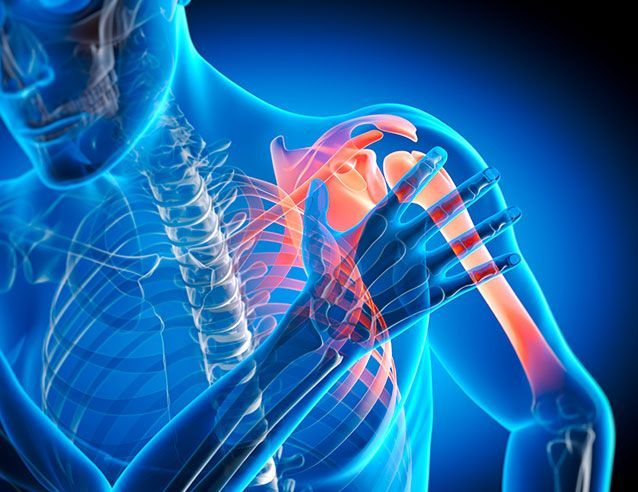
-
shoulder anatomy
The shoulder or glenohumeral joint is one of the most mobile joints in the body. For this reason, it is an unstable joint prone to dislocations, since its stability depends on the ligamentous and musculotendinous elements that surround it.
-
Why is a shoulder arthroscopy performed?
Shoulder Arthroscopy can treat shoulder problems that appear in patients with shoulder pain or limitation in movement and who have not shown improvement with their medical and physiotherapy treatment.
-
How is shoulder arthroscopy performed?
To carry out this procedure correctly, it is necessary to do it in an operating room where the patient will undergo general, regional or mixed anesthesia, and through 2 to 4 small incisions a lens with light is introduced through which it can be visualized depending on the portal through which you enter; the subacromial space or the glenohumeral joint
-
What will my recovery be like after shoulder arthroscopy?
Recovery from shoulder arthroscopy depends on the injuries to be treated and the activity to be performed by the patient. Therefore, we always work with personalized protocols.
-
Shoulder Arthroscopy Package
- First assessment consultation with a certified specialist, free/virtual. Medical fees (complete medical team for the day of the intervention, surgeon, 2 surgical assistants, 1 surgical nurse, anesthesiologist).
How is arthroscopy with Rotator Cuff repair performed?
Arthroscopic rotator cuff repair is a minimally invasive surgical repair performed on the shoulder. The goal of this surgery is to repair the rupture of one or more torn tendons in the shoulder. During arthroscopy, the tendon rupture is sutured using several anchors that join the tendon to the bone.
This intervention is performed under general anesthesia or a nerve block technique (regional anesthesia) may be offered. Arthroscopy, through small portals, allows us to visualize all the internal structures of the shoulder and repair those that are injured.
In the case of the cuff, the tendons break loose from their natural insertion in the humerus and can even shrink. Surgery is possible through the use of implants, which are a type of harpoons less than 3mm in diameter anchored to the bone and from which some suture threads come out, reattach the tendon to the bone to allow it to heal in its place of origin.
In addition to suturing the tendon, other associated gestures are sometimes performed aimed at alleviating the pain, such as cleaning the bursitis, releasing the long head of the biceps if it is injured, and if there is a space conflict between the tendons. and the bone, slightly file the bone under which the tendons pass called the acromion so that the tendons are not so trapped.
Hospitalization: 1 day
Duration: 90 to 120 minutes
Anesthesia: Regional/General or mixed
Arthroscopy with Rotator Cuff Repair
In certain cases, especially in ruptures that have existed for years, the tendons have no possibility of repair since they have retracted and the muscle on which they depend has atrophied. Even in these patients, surgery can provide relief since the Cleaning that break and the rest of the gestures that we can do on that shoulder usually have a positive effect in terms of reducing pain.
With this surgery, various pathologies can be alleviated and solutions to injuries that are more difficult to treat through open surgery. The indications for performing a shoulder arthroscopy are:
- Rotator cuff and supraspinatus and infraspinatus tendon ruptures.
- Instability and recurrent dislocations.
- Rotator cuff tendonitis.
- Calcifying tendonitis of the supraspinatus. - Ruptures of the subscapularis tendon.
- Biceps tendon.
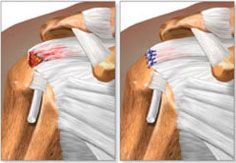
-
. What is the Rotator Cuff?
The Rotator Cuff is a set of four united muscles that, together with the tendons, develop a type of covering that surrounds the head of the humerus. This Rotator Cuff joins the humerus to the shoulder blade and its main function is to elevate and rotate the arm.
-
What is the rotator cuff used for?
It keeps the shoulder stable when the arm is moved in a specific direction.
-
What is a Rotator Cuff injury?
Rotator cuff injury is an inflammatory process, partial or total damage to the tendons of the shoulder. The rotator cuff is made up of four tendons that come together and surround the head of the humerus in front, behind and above.
-
How do rotator cuff injuries occur?
Most of these injuries are caused by wear and tear from repeatedly doing the same arm movements overhead, regardless of the type of activity.
-
Rotator Cuff Rupture Symptoms
Recurrent pain, limited ability to move the arm, and muscle weakness are the most common symptoms. If medical treatments are unsatisfactory, rotator cuff repair surgery may be an effective solution.
-
What will my recovery be like after a Rotator Cuff repair?
A well-done recovery represents 50% of the results of the surgery. It is essential to keep the shoulder immobilized for the first few weeks (4-6 weeks) so that the sutured tendons heal correctly. This can be achieved with a sling but it does not mean that the limb has to be completely immobile.
-
Arthroscopy Package with Rotator Cuff Repair
- First assessment consultation with a certified specialist, free/virtual. Medical fees (complete medical team for the day of the intervention, surgeon, 2 surgical assistants, 1 surgical nurse, anesthesiologist).
What is shoulder arthroscopy with Labrum Lesion?
It is a surgery that is carried out by making small cuts or incisions, also called arthroscopic surgery. This surgery seeks to repair the tear in the upper part of the Labrum.
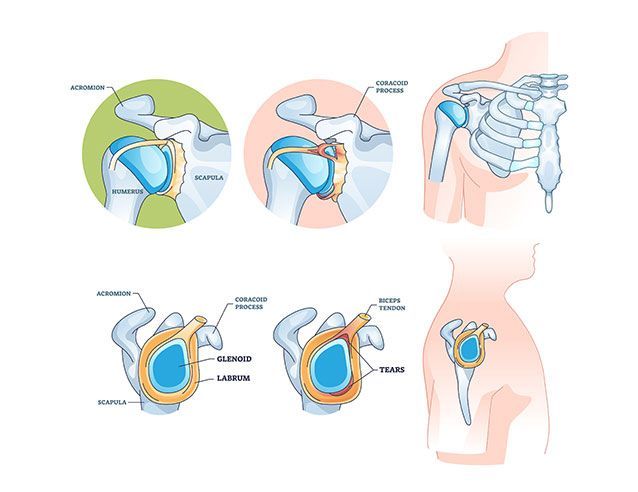
-
Anatomy of the shoulder joint space
The shoulder or glenohumeral joint is one of the most mobile joints in the body. For this reason, it is an unstable joint prone to dislocations, since its stability depends on the ligamentous and musculotendinous elements that surround it.
-
What is the Labrum?
The ring of tissue whose main function is to protect the glenoid cavity of the shoulder joint is called Labrum. This prevents the upper part of the arm bone from separating from the socket.
-
What is the Labrum for?
Prevents the top or head of the arm bone from separating from the socket
-
What are the injuries that can occur in the Shoulder Labrum?
The most common injury to the Labrum of the shoulder is a tear, which can occur due to a blow, fall, or wear and tear caused by shoulder movement.
-
Why do Shoulder Labrum Injuries Occur?
They are normally associated with direct trauma, the most common being:
-
What symptoms do Labrum lesions present?
- Acute pain.
-
How is shoulder arthroscopy with Labrum repair performed?
The patient is positioned and the shoulder is cleaned and sterilized. The surgeon makes small incisions in the shoulder and an arthroscopic camera is inserted through one of the incisions. The other incisions will be used as access points for the other arthroscopic instruments.
-
What to expect after undergoing Labrum Repair surgery?
Patients generally require the use of a sling for a period of two to four weeks following the procedure. Physiotherapy will be applied to strengthen the joint. Most patients can return to normal activities after a period of three to six months.
-
Shoulder Arthroscopy Package with Labrum Injury Repair (SLAP AND/OR BANKART)
-First assessment consultation with a certified specialist, free/virtual. Medical fees (complete medical team for the day of the intervention, surgeon, 2 surgical assistants, 1 surgical nurse, anesthesiologist).
USO OF COOKIES AND WEB BEACONS
Medical Trip informs you that our website uses its own or third-party cookies and/or web beacons to improve your experience on the site, storing your preferences and personalizing content and advertising. To disable the operation of cookies and other website data, as well as to learn about the processing of your data and information, visit our
NOTICE OF PRIVACY
Engage ---









